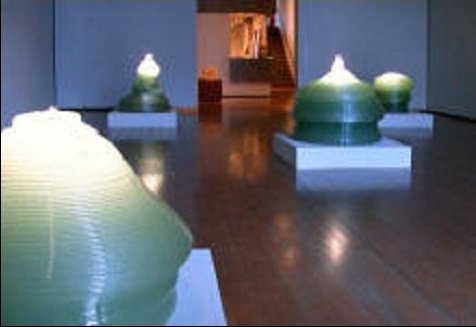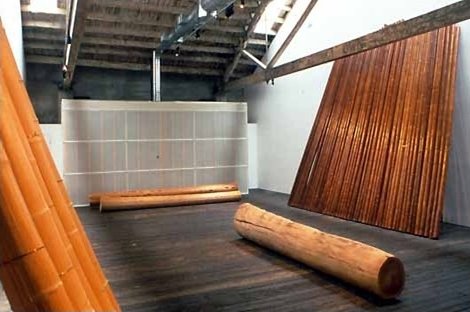| Kadonaga allows the material to speak for the art By Sheila Farr, The Seattle Times - Visual Art Friday, January 17, 2003 |
 |
| Kazuo Kadonagafs show at Greg Kucera Gallery focuses on his massive glass Sculptures. gGlass and Woodhinstallations by Kadonaga 10:30 a.m.- 5:30 p.m. tuesdays-Saturdays Through February 1 at Greg Kucera Gallery,212 Third Ave. S.,Seattle(206-624-0770) |
Kadonaga has a two-part exhibition this month. At Suyama Space, in Belltown, he's created the indoor equivalent of a Zen garden: just natural objects|wood, paper, bamboo|gently manipulated and meaningfully placed. His other show, at Greg Kucera Gallery, focuses mainly on the artist's massive glass sculptures. All the work seems worshipful, in an animistic sort of way|as if Kadonaga were intent on finding the god in each material and gently revealing it.
There's a cliche about glass being a "seductive" material, captivating enough on its own that even a mediocre artist can make something that will sweep people up in its charm. It's the shiny surface, the translucence and, above all, the lushcolors that flare up with any passing ray of light that draw people to glass.
Kadonaga frees glass from that cliche simply by letting it be itself. He doesn't bother
with color or special effects. He doesn't use the standard methods of creating form, the circus-like activity of glass-blowing or the geometric molding process that the great Czech team of Stanislav Libensky and Jaroslava Brychtova have used so brilliantly.
Kadonaga simply heats the material, releases it, and allows temperature to dictate its form. He pours a thin stream of molten glass into a warmed receptacle-kiln, letting the stuff slowly pile into a massive hive-like mound weighing about a ton. The glass takes months to fully harden.
If the process doesn't go just right, the glass cracks. To Western eyes, that's considered a flaw, says Kucera Gallery manager Jena Scott. The five pieces in the front gallery at Kucera all fit the Western notion of flawless success. Yet the artist is just as fond of some of the other sculptures in the series, ones with cracks and imperfections. He plans to have a show of those, too.
At Suyama Space, it becomes clear that for Kadonaga other materials are just as expressive as glass. When he gets his hands on giant stalks of timber bamboo or slabs of tree trunk, he doesn't seem to be making art so much as translating it. It's as if he knows the language of wood and wants to help us to understand it, too. Or maybe it's not a language but a frequency that he's atuned to. The work is so simple that the skill of making it doesn't boggle the mind: The amazing thing is the artist's receptivity. Who else would have thought to stack paper to a hefty depth and then simply compress one end of it into a slice of perfection?
 |
| At Suyama Space, Kazuo Kadonaga has crated the indoor equivalent of a Zen garden; just natural objects|wood, paper, bamboo|gently manipulated and meaningfully placed.gPure Formhsculpture by Kazuo Kadonaga 9:00 a.m.- 5:00 p.m. Mondays - Fridays through April 11 at Suyama Space 2324 Second Ave., Seattle(206-256-0809) |
Kadonaga's work gets compared to minimalism, but that
category doesn't fully capture what he's doing. The similarity is all on the
surface. Minimalism bypasses content for the pure expression of condensed form,
as dictated by the artist. In Kadonaga's case, he allows the materials to
dictate to him. Both styles of artmaking are based on a philosophy, but
Minimalism is an intellectual exercise. Kadonaga's art seems to be a spiritual
one.
Beth Sellars, curator of the Suyama Space, has been
following Kadonaga's work since the early 1980s when she first saw it at the
Space Gallery in Los Angeles. When she heard there was a traveling exhibition
at the Schneider Museum in Ashland, Ore., she figured she could find a way to
get the work to Seattle. She talked to Greg Kucera about picking up part of the
show, and he gladly agreed. Kadonaga came to Seattle to install the work|
it's an essential part of what he does|and will remain here until the Kucera part of the
show comes down.
Sellars says that
Kadonaga's underlying approach to artmaking has remained consistent throughout
his career. "He sets up a system and lets the natural aspect take
over," she said. "He allows the humidity to do its thing. All the
paper pieces here have become much more fluffy than they were at Salt Lake Art
Center (Utah), where the air is much drier. The cracks in the logs have opened
up quite a bit. The bamboos are splitting open. That's kind of a continuing
process for him. When it goes to L.A. from here it will take on another
configuration. It's kind of non-egotistical."
This joint exhibition is
Kadonaga's first exposure in the Northwest, although he has exhibited around
the world. Born in 1946, he lives in Kanazawa, Japan, and has work in the
permanent collections of the National Museum of Modern Art, Mexico; The
National Kroller Muller Museum, The Netherlands; U.C. Santa Barbara Art Museum;
and The Museum of Modern Art, Toyama, Japan, among others. If we are lucky, a
few pieces will end up in collections here as well.
The Suyama Space part of the show is called "Pure
Form." Yes, form is a major part of the show. But you can't overlook the
texture, color, rhythm and harmonics of the work. As an opera singer's voice
has color, Kadonaga's sculpture has tone.